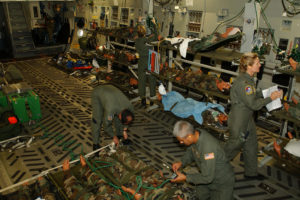CASEVAC is normally an emergency flight, transporting the patient directly from the field to the nearest medical/trauma facility, be it a field clinic or a regional hospital. CASEVAC patients are transported after only basic battlefield care by fellow combat personnel or a combat medic, in hopes of delivering the soldier to a medical facility within one hour of injury (the “golden hour” during which wounded soldiers have the highest chances of survival. While any qualifying aircraft can be used, dedicated CASEVAC aircraft are usually rotary aircraft capable of landing in unprepared terrain. Some helicopters are specifically equipped for the CASEVAC mission. However, since evacuation is time critical, CASEVAC missions are frequently conducted by the nearest general-mission aircraft, with only ad-hoc configuration to accommodate litter patients and (perhaps) a medical attendant. Many military forces not maintain specialised CASEVAC aircraft.
By contrast, MEDEVAC flights normally transport patients in stable condition after they have received care in a medical facility. While CASEVAC flights tend to cover comparatively short distances, MEDEVAC flights tend to cover medium-range to long-distance flights. They can transport patients from field hospitals to regional medical centres, or repatriate them from overseas to major hospitals in their country of origin. While rotary aircraft can conduct shorter range missions within a theatre of operation, longer range MEDEVAC flights must be conducted by fixed wing aircraft. Since MEDEVAC flights are normally pre-planned, there is time to await the availability of aircraft specifically configured for such missions.
This includes dedicated MEDEVAC aircraft as well as general-purpose transports which can be configured with a medical evacuation module. Aircraft dedicated to the medical evacuation missions are marked with the Red Cross symbol as international law prohibits firing at these aircraft. These aircraft are generally designated as MEDEVAC, even when employed in the CASEVAC role.
North America
UH/MH-60The United States Army is a prime example, utilising both general purpose and dedicated helicopters for CASEVAC missions. The multi-mission Sikorsky UH-60 utility helicopter performs medical missions on demand, while the HH-60M – a variant of the UH-60M introduced in 2007 – is optimised for this role and bears the Red Cross symbol.

Additionally, the Medical Hands-free Ultra-wideband Broadcast (MEDHUB) system, currently in development, is expected expected to enter service in 2020. It consists of networked vital signs monitors worn be patients, and data storage/communications devices, such as tablets or smart phones, operated by the medical crew. The patient data gathered in flight is automatically relayed to the receiving hospital. MEDHUB will serve a double purpose: freeing the on-board medic from recordkeeping and reporting so that (s)he can concentrate on patient care; and ensuring that the receiving facility is optimally prepared for the incoming patients.
Click here for more information
https://euro-sd.com/2019/06/articles/13678/casevac-medevac-aircraft-current-and-pending-systems/

No comments:
Post a Comment